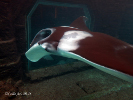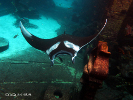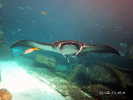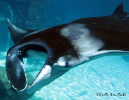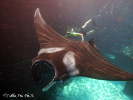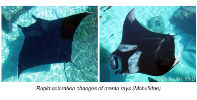Mobula birostris
(Walbaum, 1792)
Giant manta
Classification: Elasmobranchii Myliobatiformes Mobulidae
Reference of the original description
Petri Artedi sueci genera piscium. In quibus systema totum ichthyologiae proponitur cum classibus, ordinibus, generum characteribus, specierum differentiis, observationibus plurimis. Redactis speciebus 242 ad genera 52. Ichthyologiae pars III. Ant. Ferdin. Rose, Grypeswaldiae [Greifswald].
Petri Artedi sueci genera piscium. In quibus systema totum ichthyologiae proponitur cum classibus, ordinibus, generum characteribus, specierum differentiis, observationibus plurimis. Redactis speciebus 242 ad genera 52. Ichthyologiae pars III. Ant. Ferdin. Rose, Grypeswaldiae [Greifswald].
Image of the original description
No image in first description.
No image in first description.
Synonyms / new combinations and misspellings
Brachioptilon hamiltoni, Cephaloptera vampirus, Cephaloptera vampyrus, Cephalopterus manatia, Cephalopterus vampyrus, Ceratoptera ehrenbergi, Ceratoptera ehrenbergii, Ceratoptera johnii, Ceratoptera orissa, Ceratoptera vampirus, Ceratoptera vampyrus, Manta americana, Manta birostris, Manta cf. birostris, Manta ehrenbergi, Manta ehrenbergii, Manta hamiltoni, Manta orissa, Manta pinchoti, Mobula cf. birostris, Mobula manatia, Raja birostris, Raja diabolus marinus, Raja fimbriata, Raja manatia
Brachioptilon hamiltoni, Cephaloptera vampirus, Cephaloptera vampyrus, Cephalopterus manatia, Cephalopterus vampyrus, Ceratoptera ehrenbergi, Ceratoptera ehrenbergii, Ceratoptera johnii, Ceratoptera orissa, Ceratoptera vampirus, Ceratoptera vampyrus, Manta americana, Manta birostris, Manta cf. birostris, Manta ehrenbergi, Manta ehrenbergii, Manta hamiltoni, Manta orissa, Manta pinchoti, Mobula cf. birostris, Mobula manatia, Raja birostris, Raja diabolus marinus, Raja fimbriata, Raja manatia
Types
Mobula birostris
Brachioptilon hamiltoni
XXXX: No types known;
Cephalopterus vampyrus
XXXX: No types known;
Ceratoptera ehrenbergii
Syntype: ZMB: 4708 ZMB: 22621 (ex Anat.-zool. Mus. 8731)
Ceratoptera johnii
Holotype: RUSM: uncat. (whereabouts unknown)
Ceratoptera orissa
Holotype: ZSI: F72968/1
Manta americana
XXXX: No types known;
Manta birostris
XXXX: No types known;
Manta pinchoti
Holotype: USNM: 89721; Paratype: USNM: 89722; USNM: 143796; USNM: 143797;
Raja diabolus marinus
XXXX: No types known;
Raja manatia
XXXX: No types known;
Mobula birostris
Brachioptilon hamiltoni
XXXX: No types known;
Cephalopterus vampyrus
XXXX: No types known;
Ceratoptera ehrenbergii
Syntype: ZMB: 4708 ZMB: 22621 (ex Anat.-zool. Mus. 8731)
Ceratoptera johnii
Holotype: RUSM: uncat. (whereabouts unknown)
Ceratoptera orissa
Holotype: ZSI: F72968/1
Manta americana
XXXX: No types known;
Manta birostris
XXXX: No types known;
Manta pinchoti
Holotype: USNM: 89721; Paratype: USNM: 89722; USNM: 143796; USNM: 143797;
Raja diabolus marinus
XXXX: No types known;
Raja manatia
XXXX: No types known;
Description :
Citation: Mobula birostris (Walbaum, 1792): In: Database of modern sharks, rays and chimaeras, www.shark-references.com, World Wide Web electronic publication, Version 08/2025
Please send your images of "Mobula birostris" to info@shark-references.com
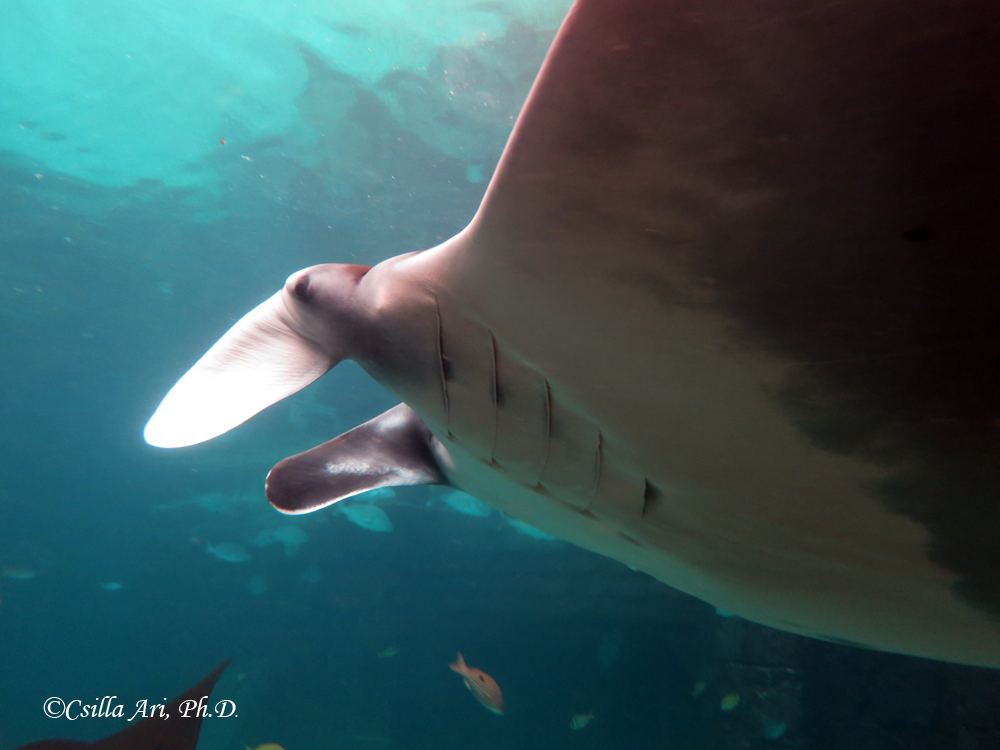
Mobula birostris (Walbaum, 1792), © Dr. Csilla Ari

Mobula birostris (Walbaum, 1792), © Dr. Csilla Ari
Common names
 Manta,
Manta,  Riesen-Teufelsrochen,
Riesen-Teufelsrochen,  Riesenmanta,
Riesenmanta,  Teufelsrochen,
Teufelsrochen,  Manta,
Manta,  Manta atlantica,
Manta atlantica,  Manta atlántica gigante,
Manta atlántica gigante,  Manta gigante,
Manta gigante,  Manta raya,
Manta raya,  Manta voladora,
Manta voladora,  Mantaraya,
Mantaraya,  Mortaja voladora,
Mortaja voladora,  Raya,
Raya,  Diable de mer,
Diable de mer,  Grande mante,
Grande mante,  Manta,
Manta,  Mante atlantique,
Mante atlantique,  Mante du Pacifique,
Mante du Pacifique,  Mante géante,
Mante géante,  Atlantic manta,
Atlantic manta,  Australian devilray,
Australian devilray,  Blanketfish,
Blanketfish,  Devil ray,
Devil ray,  Devil-ray,
Devil-ray,  Devilfish,
Devilfish,  Eagleray,
Eagleray,  Giant Atlantic manta,
Giant Atlantic manta,  Giant devil ray,
Giant devil ray,  Giant manta,
Giant manta,  Great devil fish,
Great devil fish,  Manta,
Manta,  Manta ray,
Manta ray,  Mantaray,
Mantaray,  Munguna,
Munguna,  Pacific manta,
Pacific manta,  Prince Alfreds ray,
Prince Alfreds ray,  Sea devil,
Sea devil,  Skeete,
Skeete,  Diavolo di mare,
Diavolo di mare,  Manta,
Manta,  Diabo-do-mar,
Diabo-do-mar,  Jamanta,
Jamanta,  Jamanta gigante,
Jamanta gigante,  Manta,
Manta,  Maroma,
Maroma,  Morcego-do-mar,
Morcego-do-mar,  Peixe-diabo,
Peixe-diabo,  Raia-jamanta,
Raia-jamanta,  Urjamanta
Urjamanta
 Manta,
Manta,  Riesen-Teufelsrochen,
Riesen-Teufelsrochen,  Riesenmanta,
Riesenmanta,  Teufelsrochen,
Teufelsrochen,  Manta,
Manta,  Manta atlantica,
Manta atlantica,  Manta atlántica gigante,
Manta atlántica gigante,  Manta gigante,
Manta gigante,  Manta raya,
Manta raya,  Manta voladora,
Manta voladora,  Mantaraya,
Mantaraya,  Mortaja voladora,
Mortaja voladora,  Raya,
Raya,  Diable de mer,
Diable de mer,  Grande mante,
Grande mante,  Manta,
Manta,  Mante atlantique,
Mante atlantique,  Mante du Pacifique,
Mante du Pacifique,  Mante géante,
Mante géante,  Atlantic manta,
Atlantic manta,  Australian devilray,
Australian devilray,  Blanketfish,
Blanketfish,  Devil ray,
Devil ray,  Devil-ray,
Devil-ray,  Devilfish,
Devilfish,  Eagleray,
Eagleray,  Giant Atlantic manta,
Giant Atlantic manta,  Giant devil ray,
Giant devil ray,  Giant manta,
Giant manta,  Great devil fish,
Great devil fish,  Manta,
Manta,  Manta ray,
Manta ray,  Mantaray,
Mantaray,  Munguna,
Munguna,  Pacific manta,
Pacific manta,  Prince Alfreds ray,
Prince Alfreds ray,  Sea devil,
Sea devil,  Skeete,
Skeete,  Diavolo di mare,
Diavolo di mare,  Manta,
Manta,  Diabo-do-mar,
Diabo-do-mar,  Jamanta,
Jamanta,  Jamanta gigante,
Jamanta gigante,  Manta,
Manta,  Maroma,
Maroma,  Morcego-do-mar,
Morcego-do-mar,  Peixe-diabo,
Peixe-diabo,  Raia-jamanta,
Raia-jamanta,  Urjamanta
Urjamanta
Short Description
A giant ray having an extremely broad head with long head fins, and a terminal mouth; upper surface of disc covered with denticles, and tail usually without a spine [536]. Blackish above, sometimes with white shoulder patches; white below, with grey edging on disc [536]. Tail whiplike but short [17658].
A giant ray having an extremely broad head with long head fins, and a terminal mouth; upper surface of disc covered with denticles, and tail usually without a spine [536]. Blackish above, sometimes with white shoulder patches; white below, with grey edging on disc [536]. Tail whiplike but short [17658].
Distribution
Circumtropical. Western Atlantic: Bermuda and South Carolina, USA and Brazil to Uruguay [5839], occasionally farther north [17659]. Northwest Atlantic: Canada (Ref. 5951).
New records: 2017: [25847]: near the Palomino Islets, Lima, Peru; 2019: New Ireland Province, Papua New Guinea, western Pacific Ocean [27359] Source: www.gbif.org
Circumtropical. Western Atlantic: Bermuda and South Carolina, USA and Brazil to Uruguay [5839], occasionally farther north [17659]. Northwest Atlantic: Canada (Ref. 5951).
New records: 2017: [25847]: near the Palomino Islets, Lima, Peru; 2019: New Ireland Province, Papua New Guinea, western Pacific Ocean [27359] Source: www.gbif.org
Human uses
fisheries: minor commercial; price category: medium; price reliability: very questionable: based on ex-vessel price for species in this family
fisheries: minor commercial; price category: medium; price reliability: very questionable: based on ex-vessel price for species in this family
Biology
Exhibit ovoviparity (aplacental viviparity), with embryos feeding initially on yolk, then receiving additional nourishment from the mother by indirect absorption of uterine fluid enriched with mucus, fat or protein through specialised structures [733]. Bears up to 2 young [536]; born at 122-127 cm WD [2539]. A female of 550 cm width and weighing 1050 kg was collected in the Galapagos in June and was carrying a well-developed embryo of 12.7 kg [16090]. Size at partuition might be from 1.1 to 1.3 m and from 9.1 to 1.14 kg [17014]. Yano et al (1999) (Ref. 35892) describe the mating behavior of manta rays based on observations off Ogasawara Islands, Japan, in the following sequence: 1) "quot;chasing"quot;, the male rapidly follows behind the tail of the female and attacks her several times; 2) "quot;nipping"quot;, the male nips the tip of the pectoral fin of the female and then moves to the ventral surface of the female; 3) "quot;copulating"quot;, the male inserts a clasper into the cloacaof the female and copulates abdomen-to-abdomen, up to 123 seconds; 4) "quot;post-copulating"quot;; 5) "quot;separating"quot;. (Ref. 49562). Common on coastal waters [17641]. One of the best areas to view them is around Sangalaki Island, off the northeastern coast of Kalimantan (Indonesian Borneo), [17645]. Mainly in near-shore waters, near coral and rocky reefs; sometimes found over deep water [1658]. Penetrates shallow muddy bays and the intertidal and occurs off river mouths (Ref. 9911). Pelagic [17640]. Occurs singly or in loose aggregations [1658]. Mainly plankton feeders, but may feed on small and moderate-sized fishes as well (Ref. 9911). A carnivore [17641]. Leaps out the water mainly in spring and autumn, possibly as part of mating behavior [17014]. Easily approached (Ref. 9911).
Exhibit ovoviparity (aplacental viviparity), with embryos feeding initially on yolk, then receiving additional nourishment from the mother by indirect absorption of uterine fluid enriched with mucus, fat or protein through specialised structures [733]. Bears up to 2 young [536]; born at 122-127 cm WD [2539]. A female of 550 cm width and weighing 1050 kg was collected in the Galapagos in June and was carrying a well-developed embryo of 12.7 kg [16090]. Size at partuition might be from 1.1 to 1.3 m and from 9.1 to 1.14 kg [17014]. Yano et al (1999) (Ref. 35892) describe the mating behavior of manta rays based on observations off Ogasawara Islands, Japan, in the following sequence: 1) "quot;chasing"quot;, the male rapidly follows behind the tail of the female and attacks her several times; 2) "quot;nipping"quot;, the male nips the tip of the pectoral fin of the female and then moves to the ventral surface of the female; 3) "quot;copulating"quot;, the male inserts a clasper into the cloacaof the female and copulates abdomen-to-abdomen, up to 123 seconds; 4) "quot;post-copulating"quot;; 5) "quot;separating"quot;. (Ref. 49562). Common on coastal waters [17641]. One of the best areas to view them is around Sangalaki Island, off the northeastern coast of Kalimantan (Indonesian Borneo), [17645]. Mainly in near-shore waters, near coral and rocky reefs; sometimes found over deep water [1658]. Penetrates shallow muddy bays and the intertidal and occurs off river mouths (Ref. 9911). Pelagic [17640]. Occurs singly or in loose aggregations [1658]. Mainly plankton feeders, but may feed on small and moderate-sized fishes as well (Ref. 9911). A carnivore [17641]. Leaps out the water mainly in spring and autumn, possibly as part of mating behavior [17014]. Easily approached (Ref. 9911).
Size / Weight / Age
910 cm WD (male/unsexed; [2539]); max. published weight: 3,000.0 kg (Ref. 5377); max. reported age: 20 years [17014]
910 cm WD (male/unsexed; [2539]); max. published weight: 3,000.0 kg (Ref. 5377); max. reported age: 20 years [17014]
Habitat
reef-associated; oceanodromous [17660]; marine; depth range 0 - 120 m [17640], usually 0 - ? m (Ref. 55255)
reef-associated; oceanodromous [17660]; marine; depth range 0 - 120 m [17640], usually 0 - ? m (Ref. 55255)
Remarks
shark-references Species-ID=14822; CITES: (see: Protected Species for more details) Convention on International Trade in Endangered Speciesof Wild Fauna and Flora annex: II; Council Regulation 2017/160 annex: B
shark-references Species-ID=14822; CITES: (see: Protected Species for more details) Convention on International Trade in Endangered Speciesof Wild Fauna and Flora annex: II; Council Regulation 2017/160 annex: B
Parasites (arranged by Jürgen Pollerspöck)
Trematoda
Copepoda
Trematoda
- Anaporrhutum mantae Nagaty & Abdel Aal, 1961 [23393]
Copepoda
- Anthosoma crassum (Abildgaard, 1794) [15305] [27172]
- Entepherus laminipes Bere, 1936 [15950] [15305] [27172]
- Eudactylina diabolophila Deets, 1994 (nomen nudum) [17867]








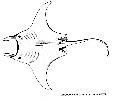
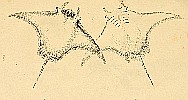
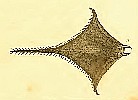
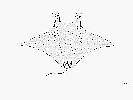
.JPG)
.JPG)
.JPG)
.JPG)
.JPG)
.JPG)
.JPG)
